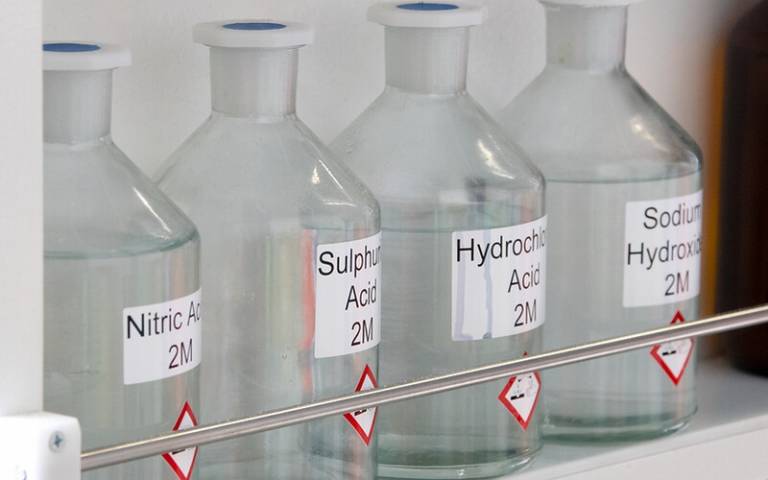Safe storage and use of chemicals in hot weather
25 June 2024
As summer approaches and temperatures (hopefully) rise, storing laboratory chemicals safely can become more challenging. This article has some simple steps you can take to ensure that your chemicals are stored safely during hot weather.

Keep your chemicals cool
Every chemical purchase should come with a Safety Data Sheet (SDS) from the supplier. This document details critical information for safe handling and storage, including fire safety measures, potential chemical reactions, and – crucially for temperature control – the maximum recommended storage temperature for the chemical.
Maintaining proper temperature for chemicals
To ensure safety, liquid chemicals must be stored below their boiling point, while solid chemicals need to be kept below their sublimation* temperature (the point where they transition directly from solid to gas). Here are some practical steps to achieve this:
- Minimise sun exposure: Direct sunlight can significantly raise the temperature. Consider storing chemicals in shaded areas
- Utilise insulated storage: Insulated cabinets, rooms or refrigerators can help maintain a consistent cool temperature.
- Control airflow: Strategically placed ventilation systems can circulate cool air and remove hot air, preventing excessive temperature build-up.
By following these measures, you can create a safe and controlled environment for storing your chemicals.
* Sublimation is the conversion of a substance from a solid to a gaseous state without becoming a liquid. A good example of this is the evaporation of dry ice (frozen carbon dioxide) directly to carbon dioxide gas, without producing a liquid during the process.
If chemicals are stored outside, they must
- Not be classified as a flammable liquid (category 1, 2, or 3).
- Not be stored in air-tight containers, as this may introduce a risk of explosion when heated.
- Be stored away from sources of ignition (including direct sunlight).
When these conditions cannot be met, the department may consider temporarily relocating their chemicals inside, following a suitable and sufficient risk assessment and supporting control measures.
Don’t forget that areas of shade change as the day progresses, make sure that your chemicals are in shade throughout the day.
Ensure that your chemical store has good ventilation
Good ventilation ensures that any gases released by chemicals as they heat up do not create an explosive atmosphere risk. Where possible, mechanical ventilation should be used (e.g. local exhaust ventilation – LEV).
Regularly check your chemical stores
Check your chemicals reguarly. Are containers bulging, have lids popped off, have containers burst? If so, urgent action will need to be taken to ensure that the remaining chemicals do not pose a risk of fire or explosion.
Don’t forget your chemical waste!
Chemical wastes, and mixtures of chemical wastes, are also susceptible to high temperatures. The above measures should also be considered for your chemical wastes.
Compressed gas cylinders
Compressed gas cylinders are categorised as inert, oxidising, flammable, and toxic. Regardless of the contents of the cylinders, they should be protected from heat and kept away from flammable materials. Under extremes of temperature, the pressure inside the cylinder may cause the cylinder to rupture and cause an explosion.
Criteria for flammable liquids
- Category 1 – flashpoint of less than 23°C and an initial boiling point of less than or equal to 35°C.
- Category 2 – flashpoint of less than 23°C and an initial boiling point of over 35°C.
- Category 3 – flashpoint of greater than or equal to 23°C and less than or equal to 60°C.
> (EC) [1, Table 2.6.1] Classification, labelling and packaging of substances and mixtures
Where can I get further information
For more information or guidance, contact your Lead Safety Advisor or email biochem@ucl.ac.uk.
Feedback
Help us improve the website and let us know your suggestions, feedback, or comments. Please contact us.
 Close
Close

